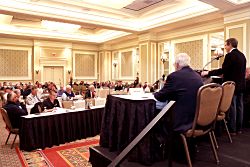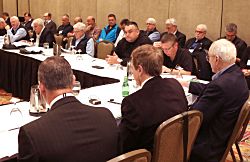Funding for social media approved as USTA Board Meeting concludes
February 29, 2016,by T.J. Burkett, Executive Editor, Hoof Beats Magazine
Columbus, OH — Funding for the social media, digital marketing initiative as well as monetary support for major-race television broadcasts were approved at the final general session of the USTA Board of Directors annual meeting Monday (Feb. 29).
A lengthy and emotional discussion preceded the votes for both spending measures. Directors presented their cases for and against allocating $250,000 of USTA money to work in partnership with Converseon Inc., a nationally-acclaimed New York City social marketing agency founded by Rob Key. The program will enter its third year in 2016, with goals including increasing online engagement by 80 percent and generating 2,000 leads to target for potential ownership of harness racehorses.

The final general session of the USTA Board of Directors annual meeting was held on Monday.
Some directors — who prefaced their statements by saying that they ultimately supported the project and voted as such — voiced their concerns about not seeing specific results from the first two years of the partnership with Converseon.
“This is something we’ve got to build upon and continue to impress upon Converseon as well over the next year that if we want certain metrics from them, then let’s get that information to Mike Tanner, to Dan Leary, so they can present it to Rob (Key). That way, he knows exactly what we are looking for in 2016,” said Jason Settlemoir (District 8, New York).
Gabe Wand (District 4, Wisconsin) echoed those concerns, calling for more accountability from Converseon and the USTA in the next year.
“They are really giving us no concrete metrics,” he said. “I want to know how many non-horse racing people are we reaching? Or are we just building a platform for ourselves?
“If we continue to go forward with this, if by this time next year can directors be guaranteed some type of a score sheet on how we’re doing — and if we have a plan B?”
Those who voted against the funding raised questions about spending money when the 2016 budget approved by the board shows a projected deficit in 2016. The 2015 budget projected a deficit of $108,947, but finished with a surplus of $348,357 due to decreases in office expenses and unused budgeted funds allocated to such projects as television production, Save Our Standardbreds, investigative services and Strategic Wagering shortages.
“I don’t think there is any question that we need to be in social media,” said John Brennan (District 12, New Jersey). “I think the question is: Can this be done in-house? I just don’t think that with the deficit that we have, that we are in a position to be spending this money.”
USTA Executive Vice President and CEO Mike Tanner explained that the USTA did not have the resources to go from managing to monetizing social media.
“There seems to be a fundamental misunderstanding as to what the social media initiative is,” said Tanner. “The social media is not Allison Conte and Dan Leary and Ken Weingartner just tweeting a whole lot and posting things on Facebook. The social media initiative is doing those things while having the infrastructure to read where those messages are going, to determine who is receiving those messages, to get the demographics and build content for them so we can branch out into a CRM (customer relationship management) initiative, just like the casinos do to build customers.”
Before a roll-call vote was cast for the social media and television spending, Brennan made a motion to instead conduct a secret-ballot vote. The motion needed approval of two-thirds of the directors in attendance, but the roll call vote for that motion was defeated with 23 voting “yes” and 21 voting “no.”
The roll-call vote to approve the funding for social media passed by a measure of 36-4. (Editor’s Note: A previous version of this story listed the results as 36-3.)
Prior to the social media vote, a roll-call vote to approve a $120,000 fund to help support harness racing television broadcasts passed by a measure of 39-3. The monies in the fund would be made available to any racetrack or group that applied to coordinate the production and broadcast of one or more of their major races.

USTA/Mark Hall photos
Members of the USTA Finance Committee met in the morning.
In order to address the deficit questions outlined in brief above, a price increase for selected USTA services was approved by a voice vote in both the general session and the Finance Committee meeting prior. Starting in 2018, fees for individual USTA memberships would increase from $50 to $75; and from $140 to $200 for three-year memberships. Member racetrack dues would be increased according to a scaled amount based on purses; and eTrack services would rise from $168 per day to $200 per day for most tracks. According to Chairman Ivan Axelrod, the measures would increase revenue some $600,000 per year after the third year of implementation.
The price increase was met with concerns from some directors in the Finance Committee.
“Do you think that instead of raising fees — especially in the membership category — that we could maybe go back and pick through the budget and ‘trim the fat?’” asked Mark Ford (District 8, New York). “Regardless of how you put it, a rate increase at this point in time is not going to be well-taken.”
Tanner responded by reminding directors that employee count has reduced from 60 to 49 in the past few years and any cuts to the budget would result in the elimination of the myriad sponsorships and staff support that the USTA provides across the industry.
“You can always get leaner, but you are going to lose services by doing that,” he said. “The rest of the industry is shrinking and the expectations put on the USTA are greater than ever. We jump in and we jump in quietly to provide support, doing things that 20 years ago we were never expected to do.”
The Rules Committee met in the first session of the morning, and made the following decisions to the submitted rule changes for 2016.
Rule Change No. 1: Tabled
No. 2: Approved
No. 3: Approved
No. 4: Rejected
No. 5: Rejected
No. 6: Rejected
No. 7: Approved as amended to 60 days
No. 8: Rejected
No. 9: Rejected
No. 10: Approved
No. 11: Approved as amended to remove “Loud shouting or other…”
No. 12: Withdrawn by sponsor
No. 13: Rejected
- Progress of social media marketing program discussed as USTA Board of Directors Meeting opens (Saturday, February 27, 2016)
The progress of the USTA-led social media marketing program was presented and debated vigorously during the opening day of the USTA Board of Directors Annual Meeting Saturday (Feb. 27) at the Hilton-Easton.
- General session kicks off USTA Board of Directors meeting on Sunday (Sunday, February 28, 2016)
The USTA donated $10,000 to the fight against decoupling in Florida and a challenge to the election of track directors in Ohio was defeated during the general session of the USTA Board of Directors Annual Meeting Sunday (Feb. 28) at the Hilton-Easton.
- USTA donates $10,000 to Florida decoupling effort (Sunday, February 28, 2016)
At Sunday’s (Feb. 28) Board of Directors Annual Meeting, USTA President Phil Langley presented a $10,000 check to Florida Standardbred Breeders and Owners Association President Joe Pennacchio to aid in the effort to oppose decoupling in Florida.
- New registration product demonstration highlights Sunday USTA Board committee meetings (Sunday, February 28, 2016)
The demonstration of a new registration product through USTA Online Services highlighted committee meetings on Sunday (Feb. 28) at the USTA Board of Directors meeting at the Hilton-Easton.
